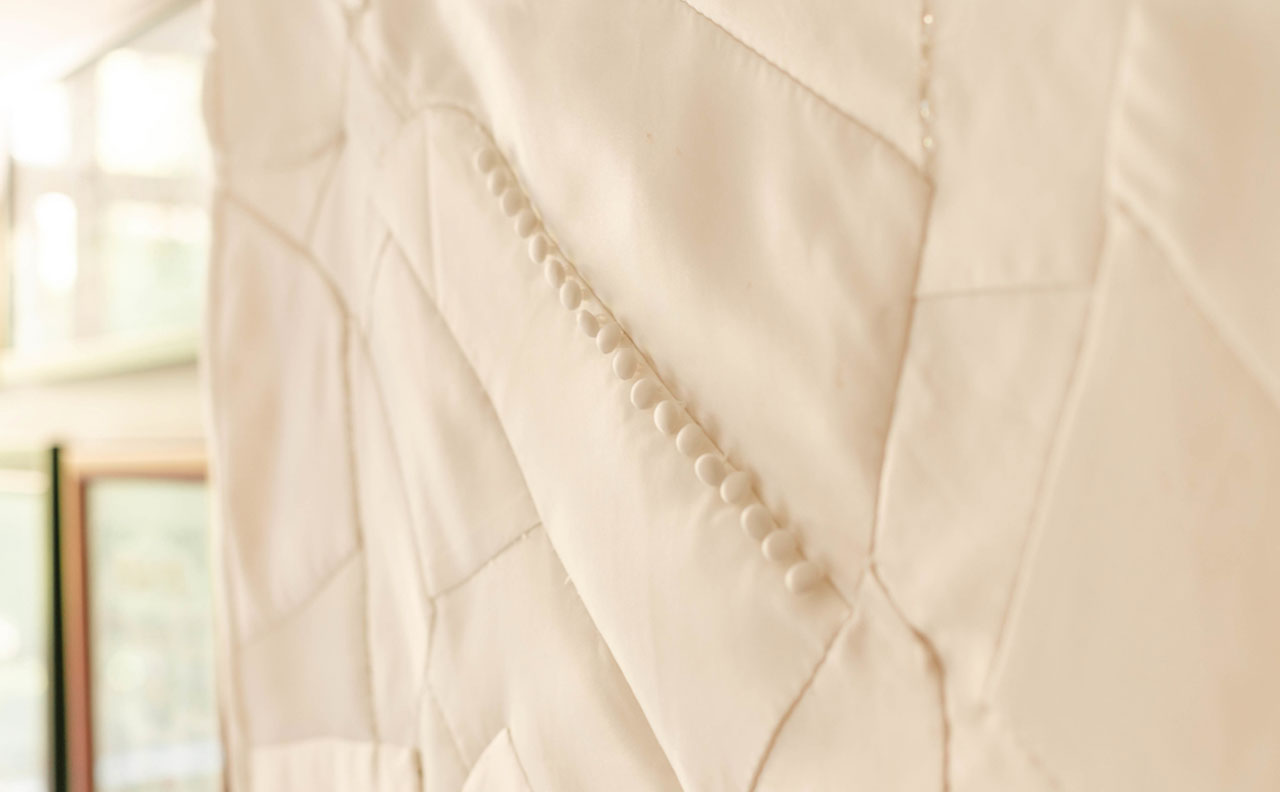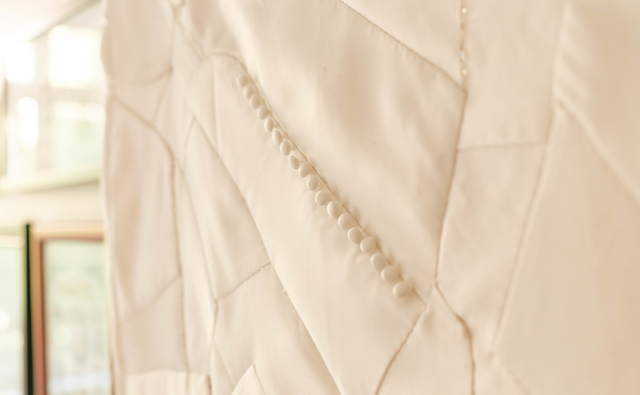From Rags to Riches
Kate Miller
Taking scissors to my wedding dress, I confess, was a subversive act. My wedding dress is the most valuable article of clothing I’ve ever owned. Cost aside, a bridal gown at any price is the most sacred garment in our culture. To cut a perfectly good dress to pieces is one thing, but to take shears to what I wore when I vowed “I do” is a cultural “don’t.” And yet, happily married for many years, scrutinizing a single-use outfit taking up prime closet real estate, my endeavour to dismantle the dress for a quilt was not profane. Turning my wedding gown into a quilt continues to honour the meaning of the material, a profound celebration of 100% polyester.
Of course, I feel this way about all of my quilts. The shock of red belonging to the trousers my son loved to wear, the check shirting my husband wore when we were dating, and the recognizable weft of my maternity denim all bear significance to me. But I do not think the quilts are only evocative to me or the people with a connection to the fabrics. Quiltmaking is always a transfigurative craft; it elevates rags to riches, sees the precious worthiness of material, boosts it, and revels.
But I do not think the quilts are only evocative to me or the people with a connection to the fabrics. Quiltmaking is always a transfigurative craft; it elevates rags to riches, sees the precious worthiness of material, boosts it, and revels.
Indeed, my wedding dress cost more than all of the other pieces of clothing used in my quilts combined. But this is a distortion of value. Given that it takes about 10,00 litres of water to make a pair of jeans, or that the global garment industry operates by the exploitation of garment workers, or that one garbage truck of textiles is sent to the dump every second, or that more than half of our clothing is made from petroleum products, monetary value is a poor indicator of true cost. Deconstructing clothing, seeing the cloth for what it is, and repurposing it enables one to reimagine the material’s merit.
I chose to render the wedding dress fabric in an unusually-monochromatic Crazy Quilt, incorporating the beads and buttons for its embellishment. As much as the technique echoes the haphazard frenzy of colours and patterns and textures that a quilter could use, Crazy Quilting gets its name from the cracked or crazed appearance of the irregular patchwork. During its heyday in Victorian North America, these quilts characteristically showcased the best bits of fine silks and sentimental cloth that a quilter collected, boasted of her embroidery prowess, and were particularly ornamental rather than utilitarian. As a form, Crazy Quilts are an intentionally ostentatious and rather schmaltzy kind of patchwork—the opposite idea of making something out of nothing and creating unity from cast-offs. Here, where each sliver of fabric is celebrated as much as its adjacent, gathered together and imbued with meaning, the Crazy Quilt is a feast of scraps.
Of course, I feel this way about all of my quilts.

She Makes Bedcoverings is four large-scale quilts made from her family’s discarded clothing, entirely by hand. From using mass-produced children’s clothing to her own wedding dress, and employing different hand-quilting techniques, the quilts challenge the way that material resources, industrialized fashion, and craft knowledge are valued. Her study of Amish quiltmaking and connoisseurship aims to reconcile the false dichotomy of art and craft, recovering a theological vision of the arts rooted in gratuity, vocation, and wisdom.
Follow her work on Instagram @kviiimiller
Photographed by Samuel Supimpa
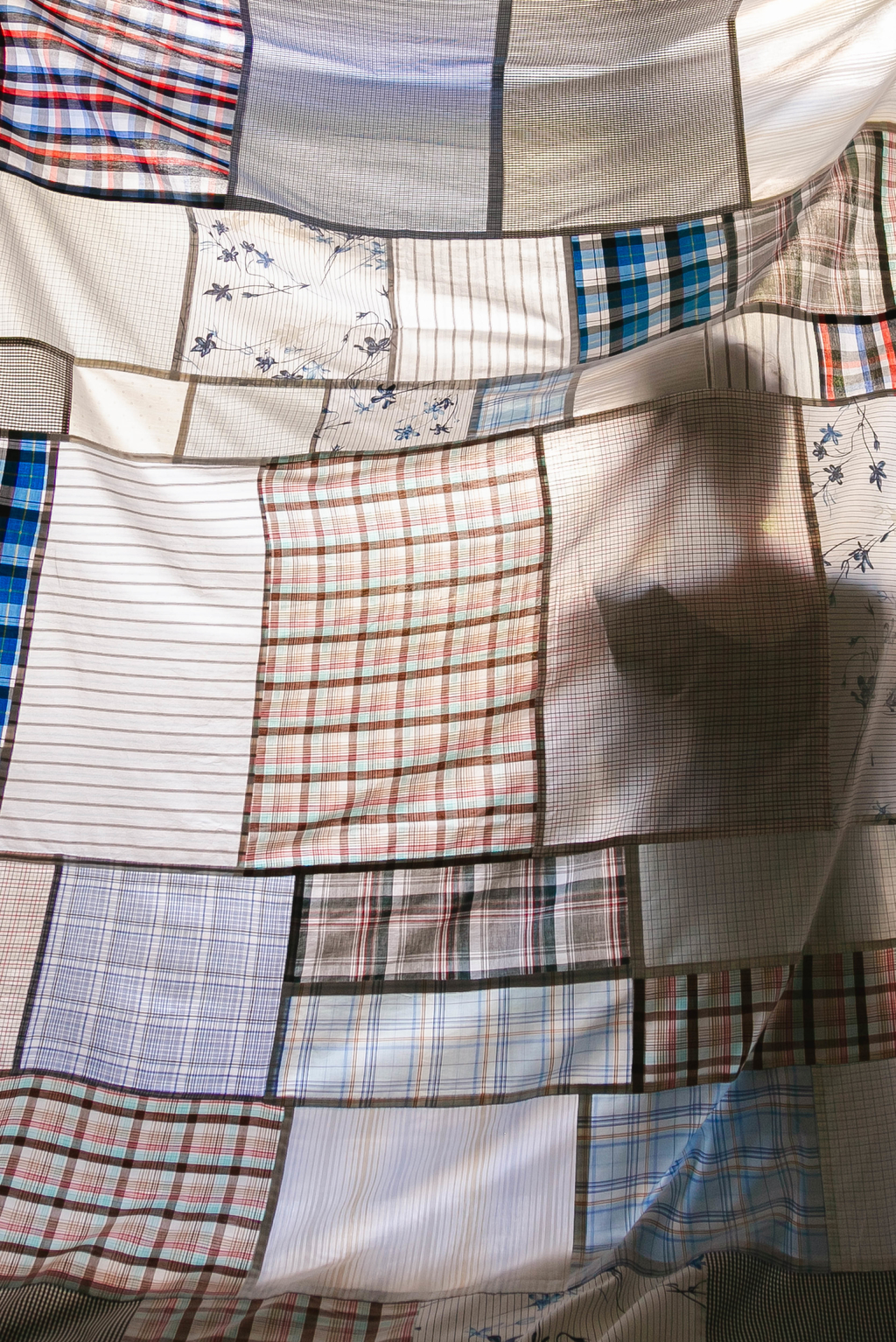
She Makes Bedcoverings is four large-scale quilts made from her family’s discarded clothing, entirely by hand. From using mass-produced children’s clothing to her own wedding dress, and employing different hand-quilting techniques, the quilts challenge the way that material resources, industrialized fashion, and craft knowledge are valued. Her study of Amish quiltmaking and connoisseurship aims to reconcile the false dichotomy of art and craft, recovering a theological vision of the arts rooted in gratuity, vocation, and wisdom.
Follow her work on Instagram @kviiimiller
Photographed by Samuel Supimpa
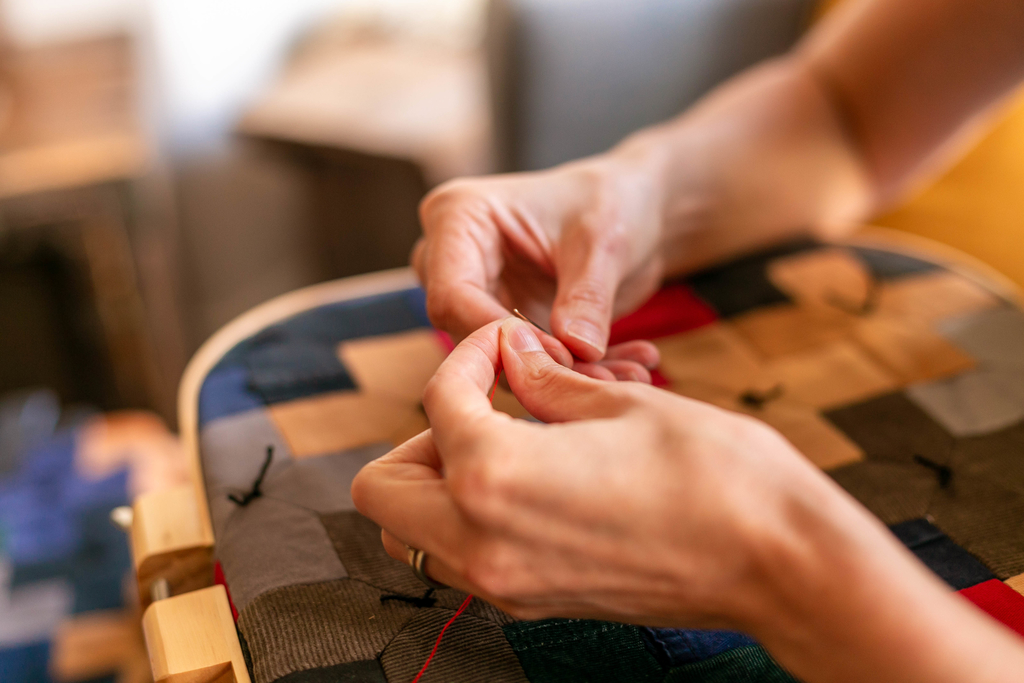
She Makes Bedcoverings is four large-scale quilts made from her family’s discarded clothing, entirely by hand. From using mass-produced children’s clothing to her own wedding dress, and employing different hand-quilting techniques, the quilts challenge the way that material resources, industrialized fashion, and craft knowledge are valued. Her study of Amish quiltmaking and connoisseurship aims to reconcile the false dichotomy of art and craft, recovering a theological vision of the arts rooted in gratuity, vocation, and wisdom.
Follow her work on Instagram @kviiimiller
Photographed by Samuel Supimpa

She Makes Bedcoverings is four large-scale quilts made from her family’s discarded clothing, entirely by hand. From using mass-produced children’s clothing to her own wedding dress, and employing different hand-quilting techniques, the quilts challenge the way that material resources, industrialized fashion, and craft knowledge are valued. Her study of Amish quiltmaking and connoisseurship aims to reconcile the false dichotomy of art and craft, recovering a theological vision of the arts rooted in gratuity, vocation, and wisdom.
Follow her work on Instagram @kviiimiller
Photographed by Samuel Supimpa
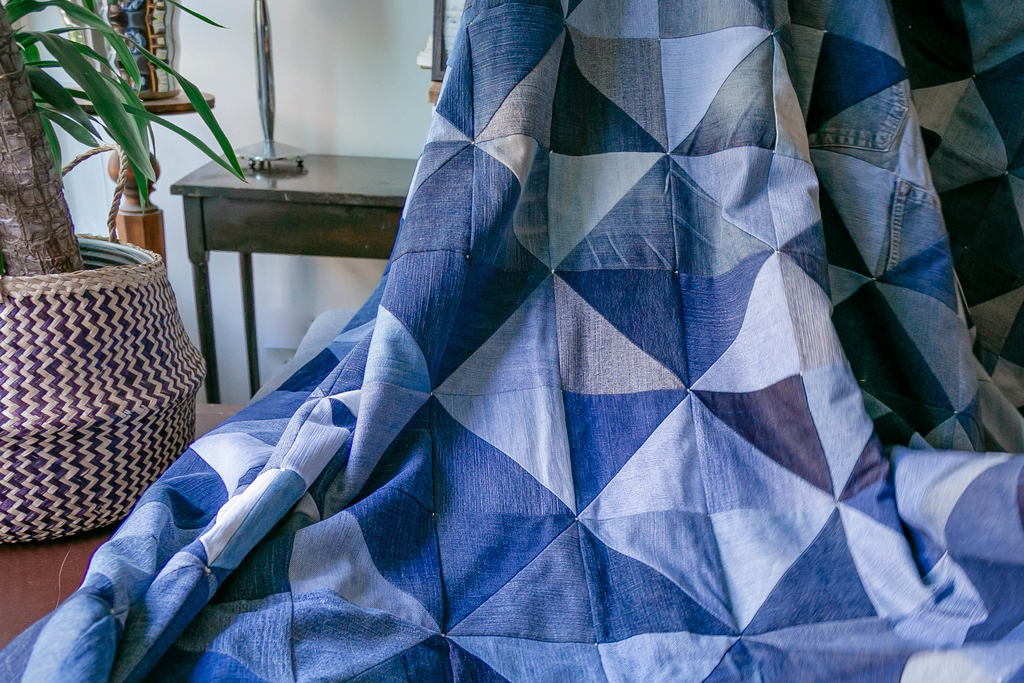
She Makes Bedcoverings is four large-scale quilts made from her family’s discarded clothing, entirely by hand. From using mass-produced children’s clothing to her own wedding dress, and employing different hand-quilting techniques, the quilts challenge the way that material resources, industrialized fashion, and craft knowledge are valued. Her study of Amish quiltmaking and connoisseurship aims to reconcile the false dichotomy of art and craft, recovering a theological vision of the arts rooted in gratuity, vocation, and wisdom.
Follow her work on Instagram @kviiimiller
Photographed by Samuel Supimpa

